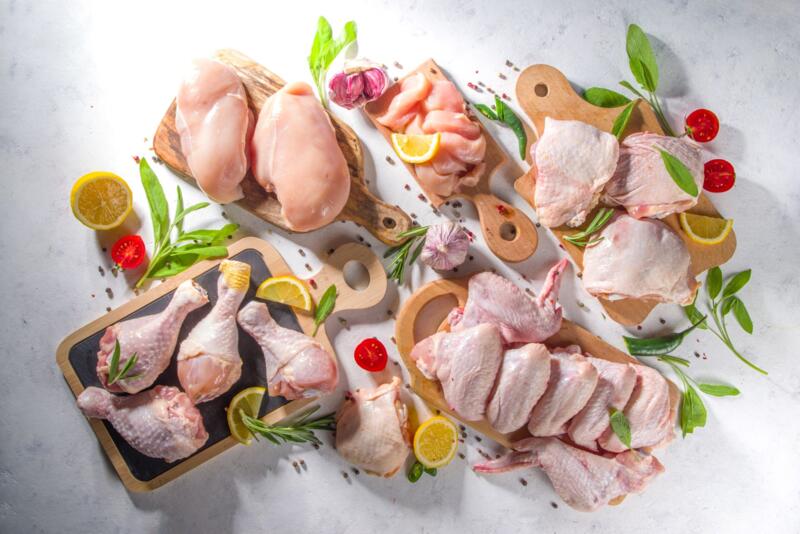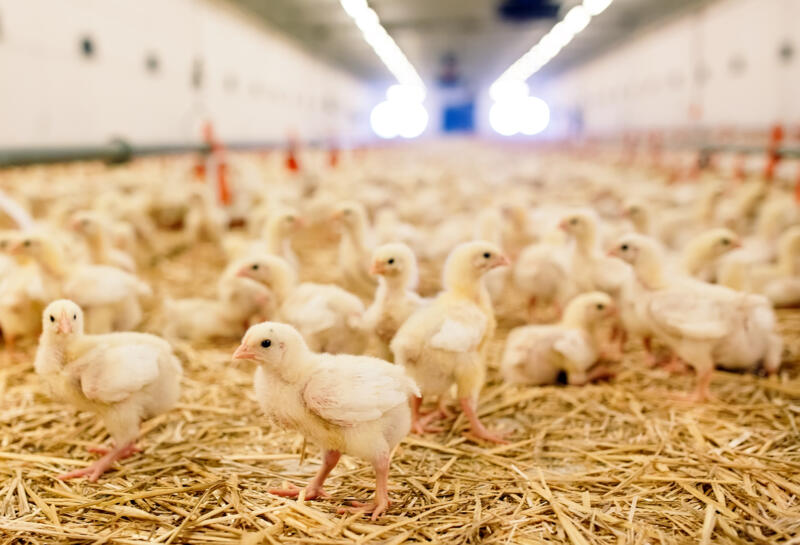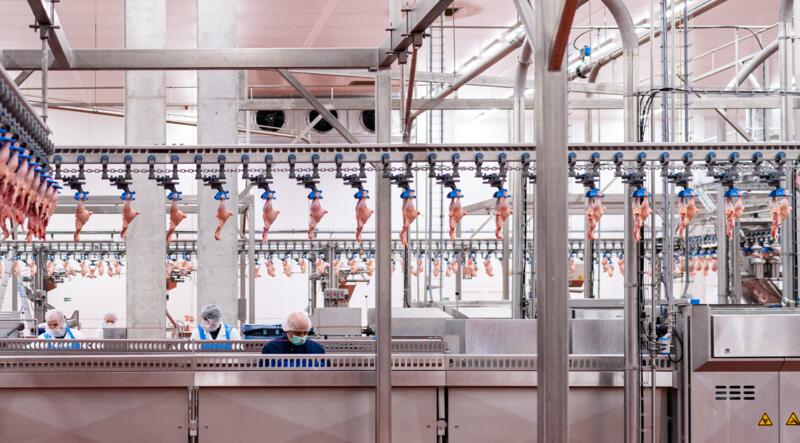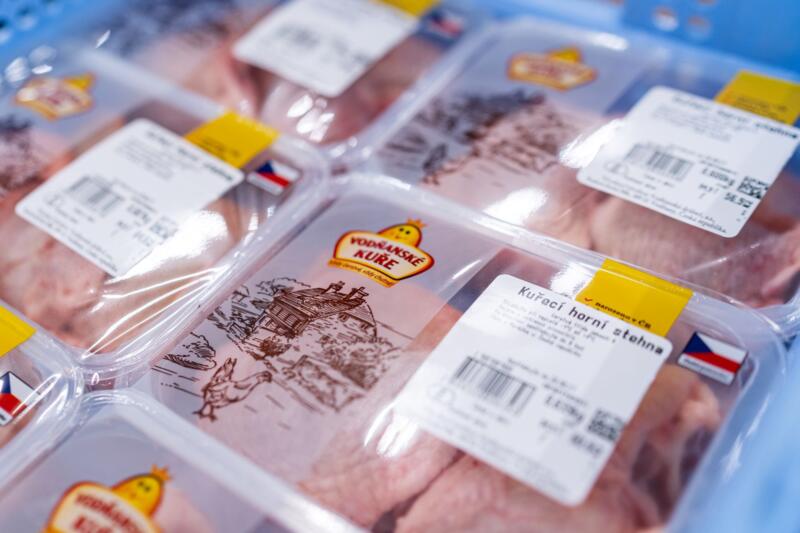Everything about the production
GENERAL CHARACTERISTIC
Poultry meat ranks among the basic kinds of meat and constitutes an important part of the offer on the food market becoming increasingly popular in recent years. The most significant factors influencing the rising consumption include its excellent dietetic properties, easy and fast preparation, a continuously growing offer of products and semi-manufactured chicken products and, last but not least, its favourable price.
Poultry meat is easily digestible as it possesses fine muscle fibres not containing collagen, and for that reason – unlike other kinds of meat – it can be easily prepared. Consuming poultry meat and poultry meat products is very beneficial and belongs to a healthy diet. The processing that makes the meat the most dietetic and digestible includes boiling, stewing and hot-air cooking. Our consumers prefer chilled poultry meat, poultry portions and products with a higher added value.
The popularity of poultry meat has led to an increase in its consumption. In 2015, the consumption of poultry meat in the Czech Republic reached 26 kg/person/year, and in 2016 it was almost 27 kg/ person/year; further growth is expected. There is a continual increase of the consumption of chilled (fresh) meat in comparison to frozen or deep-frozen meat. The percentage of chilled meat exceeds 80 %.

BREEDING METHOD
The production process necessary for a safe, high-quality final product is subject to checks ranging from the preparation of compound feeds, hatching the chicks and their feeding on the farm up to the processing of the final products in production plants. Breeders, transporters and processors of the chickens observe all legislative requirements of poultry farming and animal protection against cruelty. These legislative requirements define, among other things, the maximum stocking density of chickens kept for meat and the resulting obligations of the poultry breeder. Nowadays, breeders are obliged to ensure many further welfare parameters for the animals. These include temperature and light regimes, optimum air humidity, the contents of carbon dioxide, ammonia and a number of others. The poultry is kept in closed halls on bedding or turf, with free range and unlimited access to feed and drinking water.
PROCESSING METHOD
Transporting, slaughtering, carcass dressing and the actual processing of poultry are carried out under permanent veterinary checks of the entire production process. At the same time, continuous surveillance in the course of slaughtering and the actual processing is conducted by duly trained employees of the slaughterhouse operator. Quality poultry meat production is based on observing animal welfare, up-to-date carcass dressing, thorough chilling and multiphase quality checks.
Carcass dressing of poultry is conducted in plants that meet the strict legislative veterinary regulations on the approval and registration of food-processing plants, poultry slaughter and related or follow-up sections.
Carcass dressing of poultry is divided into several separate technological sections, consisting of continual lines and a system of separate machinery equipment though which the poultry passes in the particular phases of processing (e.g. slaughtering, cleaning, chilling, portioning, packaging, dispatching, etc.).
The premises for the reception of slaughter poultry and the assessment of poultry are sufficiently large, ventilated, well-lit and clean. The loading, transporting, unloading and stunning of poultry are carried out in such a way that prevents injuries and stress in the animals that might have an adverse impact on their health and welfare or on the health harmlessness and quality of the products. Up-to-date systems of handling the poultry are introduced both during the slaughters and on farms.
A veterinary check is conducted on the arrival of the animals before they are slaughtered. The shackling of live poultry is carried out in a separate room. Following that, the animals are stunned and bled. Then they are deplumed, eviscerated and cleaned. A veterinary check of the meat and giblets is followed by cleaning and washing the processed bodies, chilling them, and portioning, packaging and dispatching the poultry meat.
The correctness of the procedures is checked during the entire production process with special focus on critical points, i.e. defined steps of the process, in which decisive parameters necessary to prevent or eliminate food safety risks are checked.

CHILLING POULTRY MEAT
Although the EU legislation allows various chilling methods, we use exclusively air chilling or air chilling with light misting. Our plants have been using this modern technology for over 20 years. This chilling method makes the poultry perfectly chilled in all parts to the required temperature of max. 4°C. The meat is chilled individually in chilling tunnels. These kinds of treatment are more expensive than chilling by water but they guarantee a higher quality of poultry meat. Air chilling or air chilling combined with light misting results in a lower or no content of residual water in the chickens and chicken portions because this chilling method prevents the absorption of water into the meat, and excessive drying of the chicken body surface if it is combined with light misting.
This process guarantees that when consumers buy our poultry meat, they do not buy water for the price of meat.
PROCESSING POULTRY MEAT AND ITS PRODUCTS
We supply the market with poultry, whole and portioned, thermally processed poultry meat products and poultry products intended for thermal processing.
We supply the market with poultry meat prevailingly in chilled (fresh) state, to a lesser extent with deep-frozen meat.
According to the legislation, dressed poultry carcasses are divided into the following kinds and groups:
Chicken wings
Chicken quarter
Chicken breast
Chicken breast steak
Chicken leg that can be divided into lower and upper leg
Boneless chicken leg without – chicken leg steak with or without skin
Chicken back
Rear half
Front quarter, rear quarter
Leg
Upper leg
Lower leg
Leg steak
Breast
Breast steak
Breast filets
Chicken breast Supreme
Poultry giblets include the following organs and body parts: heart, neck, muscular stomach and liver.
QUALITY CLASSES OF POULTRY
Dressed poultry carcasses and portioned poultry meat are divided into two quality classes. Poultry in the A and B quality classes is unimpaired and clean, with no foreign substances, impurities or blood, with no strange smell, protruding broken bones and visible contusions.
Poultry in the A quality class is also of a proper body construction and full flesh. The breasts and legs are well developed and fleshy. The breast, back and upper leg parts of the chickens contain a thin subcutaneous fat layer. The ends of the wings can be removed.
Frozen or deep-frozen A quality class poultry must not show any traces of freezer-burn except those that re incidental, small and unobtrusive and are not present on the breast or legs.
Retail network is supplied solely with A class poultry meat.
LABELLING POULTRY MEAT
When labelling poultry meat, the product name, the producer’s name and address, quality class data, whether the poultry is chilled (fresh) or deep-frozen, information concerning the conditions under which the meat is to be stored (storage temperature) are specified on the label or on the product package. The package also bears the date of the shelf life of chilled (fresh) poultry meat or the date of minimum storage life and the freezing date of deep-frozen poultry meat.
Shelf life denotes the period during which the product retains its quality parameters on condition that the storage temperature is observed. Minimum storage life is specified for frozen, deep-frozen and durable products. For that reason, it is necessary that the transporter, retailers and consumers observe the storage temperatures specified on the product packaging.
Marking the storage conditions and the country of origin of poultry meat is also important. Obligatory marking applies to EU member states or third countries in which the poultry was bred and in which it was slaughtered. Consumers can refer to this important information when choosing poultry meat.
Identification labels of animal products
Another piece of information is the oval-shaped label denoting the safety of packed poultry meat, which enables the consumers to identify the place in which the animals were slaughtered. The registration number of the slaughter, portioning and packaging plants provides information about the EU member state or the third country in which the poultry was slaughtered, portioned or packed. If these plants are situated within the territory of the Czech Republic, detailed information about these plants can be found on the internet web page of the State Veterinary Administration of the Czech Republic by means of the registration number provided.
All the above information must be specified on the cover of each package sold.

COMMERCIAL PACKAGING OF POULTRY
Poultry meat and poultry meat products are supplied to the market in immediate packaging. Protective atmosphere packaging, which greatly contributes to extending the storage life of the products, has grown considerably in recent years. We provide both small-scale and large-scale consumer packaging.
When processing and packaging our products, we observe the principle of non-contamination. The packaging materials comply with the legislative requirements for products intended for contact with food. Packaging materials and packages are stored in separate storage premises. We register all production batches for the purpose of traceability of all the products that we supply to the market network.
STORING POULTRY MEAT AND PRODUCTS BEFORE DISPATCH
Meat and meat products are stored in storehouses at a controlled temperature – the cold stores. These premises are equipped with devices that permanently measure and register the set temperatures. All surfaces in the stores are rustproof and are cleaned and disinfected.
Our products are regularly checked both by the State Veterinary Administration and by our technical staff, in accordance with the legal requirements. Samples of our products and meat are regularly sent by the staffers of the State Veterinary Administration or by us to accredited laboratories for examination. Every day, we collect production samples that are stored under temperatures laid down by law and sensorially assessed at the end of the storage life. The results of the laboratory examinations are used – among other – to increase the hygienic quality and the safety of the entire productions process.
MEANS OF TRANSPORT
To transport our products we use up-to-date means of transport that can be easily cleaned and disinfected. They are equipped with refrigerating and freezing devices and with apparatuses to measure and register the set temperatures. These are not used for the transport of other products that could have unfavoured effects on the meat and contaminate it.
